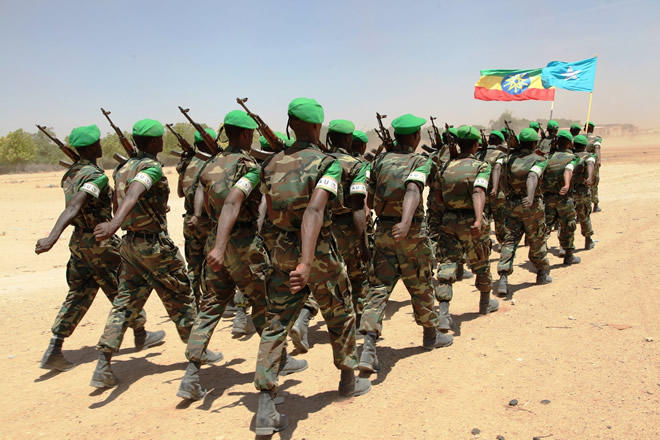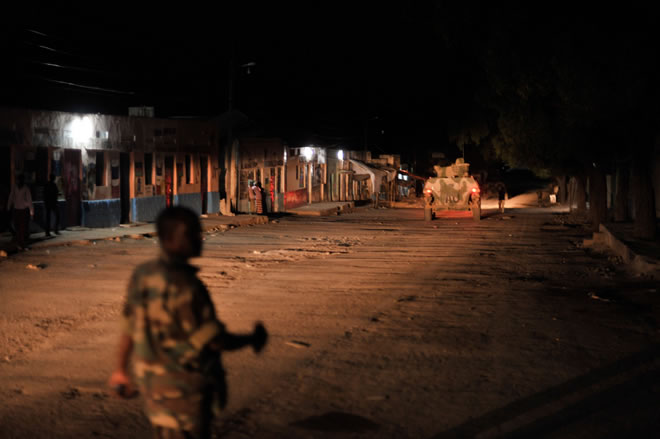 There’s a few unusual things about Ethiopia. First, it has a pretty small military budget. Second, it’s in a dangerous neighborhood. Addis Ababa is in a cold war with its heavily-armed neighbor Eritrea and shares a border with Somalia—home to the terror group Al Shabaab.
There’s a few unusual things about Ethiopia. First, it has a pretty small military budget. Second, it’s in a dangerous neighborhood. Addis Ababa is in a cold war with its heavily-armed neighbor Eritrea and shares a border with Somalia—home to the terror group Al Shabaab.
At the same time, the Ethiopian military is pretty good.
“In part due to previous lessons learned, to date Ethiopia has been able to foil any significant terrorist attacks by Al Shabaab, though not for lack of trying by the terrorist organization,” OE Watch, the U.S. Army’s Foreign Military Studies Office monthly newsletter, recently noted.
The Ethiopians “scare the Hell out of everybody,” Alexander Rondos, the European Union’s representative for the Horn of Africa, said in 2014.
By global standards, Ethiopia’s military spending as a percentage of its GDP is low—only around 0.8 percent—which puts it in the bottom half of countries.
By African standards, the dollar amount spent—around $330 million per year or so depending on the source—is middling. Ethiopia is one of the few countries on the continent that decreased its defense budget during the past decade, according to data from the Stockholm International Peace Research Institute.
Despite this, Ethiopia has one of the strongest armies in Africa, arguably outmatched only by Egypt, Algeria and South Africa. And these three countries spend far more on their militaries, both in per capita terms and in actual dollars, than Ethiopia.
Ethiopia fields more than 135,000 soldiers and hundreds of T-55 and T-72 tanks. Boosting this firepower, Ethiopia bought 200 more T-72 tanks from Ukraine in 2011.
Its air force is tiny, but fields a diverse group of older Russian fighters and more capable Su-27s and Czech-made L-39 trainers. The landlocked country, to be sure, has no navy.
The Ethiopian army is currently the fourth largest contributor to peacekeeping missions in the world when it comes to raw manpower. In short—don’t mess with Ethiopia.
So what is Addis Ababa doing right? Here’s a few tips. Focus on training, try to build weapons yourself and learn from experience.
A lot the country’s success derives from hard lessons learned during the Eritrean-Ethiopian War in the late 1990s. The badly-equipped Ethiopians took heavy losses and tens of thousands of soldiers died.
“It took several months and lots of money for the country to revamp the military and repel Eritrea’s attack,” journalist Abel Abate Demissie wrote in The Reporter. “Consequently, the country started to modernize its military and security apparatus both in terms of quality and quantity.”
Ethiopia invested heavily in training and producing its own weapons. Addis Ababa now makes its own version of the AK-47 rifle and PKM machine gun. It assembles its own grenade launchers and ammunition. The country’s arms industry can manufacture and refurbish tanks and armored vehicles—although they’re older Soviet-style models.
Ethiopia also churns out a lot of hardware for other African militaries engaged in peacekeeping. The country is the main weapons manufacturer for the African Union.
“Some say the best lesson Ethiopia learned,” OE Watch noted, “which it readily implements, is to launch proactive strikes against its enemies.”
But there’s an ugly side to this. Ethiopian troops have often extended those proactive strikes against civilians.
In 2006, Ethiopia invaded Somalia, occupied Mogadishu and overthrew the ruling Islamic Courts Union. This resulted in a new civil war with the violently jihadist Al Shabaab taking the comparatively-moderate ICU’s place.
The Ethiopian troops largely withdrew in 2009 under pressure from the African Union, which had deployed peacekeepers into the lawless country.
One reason A.U. wanted them gone—the Ethiopian soldiers murdered a lot of people. They gang-raped women and slaughtered Somali civilians “like goats,” a 2008 Amnesty International report stated.

“Ethiopian soldiers were accused of committing a wide range of atrocities, including firing mortars on civilian hospitals, press institutions, and houses, and rape, theft, kidnapping, and murder of Somali civilians,” according to a 2014 study published by the U.S. Army’s Joint Special Operations University.
But in 2014, the Ethiopians formally joined the African force and returned to Somalia. Today, there’s nearly 4,400 of Addis Ababa’s soldiers in the country—part of the 22,126-strong A.U. contingent.
Somalis still widely loathe the Ethiopians, but the troops are under A.U. command—and Somalia is now more stable than it has been in years.
Ethiopia has avoided a large-scale Al Shabaab attack, such as the 2013 siege on the Westgate shopping mall in Nairbobi, Kenya. Sixty-seven people died in the assault.
But this has a lot to do with Ethiopia aggressively policing its border. One factor that’s helped is that the terror group doesn’t exert much influence near the border. Instead, its territory directly abuts against Kenya.
Politicians and generals around the world often argue that bigger budgets and military effectiveness have a direct correlation — like a formula that shows an army getting tougher the more money you pour into it.
But a bloated budget can lead to a military being worse off—if a country squanders the money and spends it on the wrong things.
“In emphasizing troop training and modern, domestically produced, equipment, [Ethiopia] has managed to keep its military expenditures low, its armed forces well prepared, and its territory relatively safe from attack,” OE Watch stated.






























